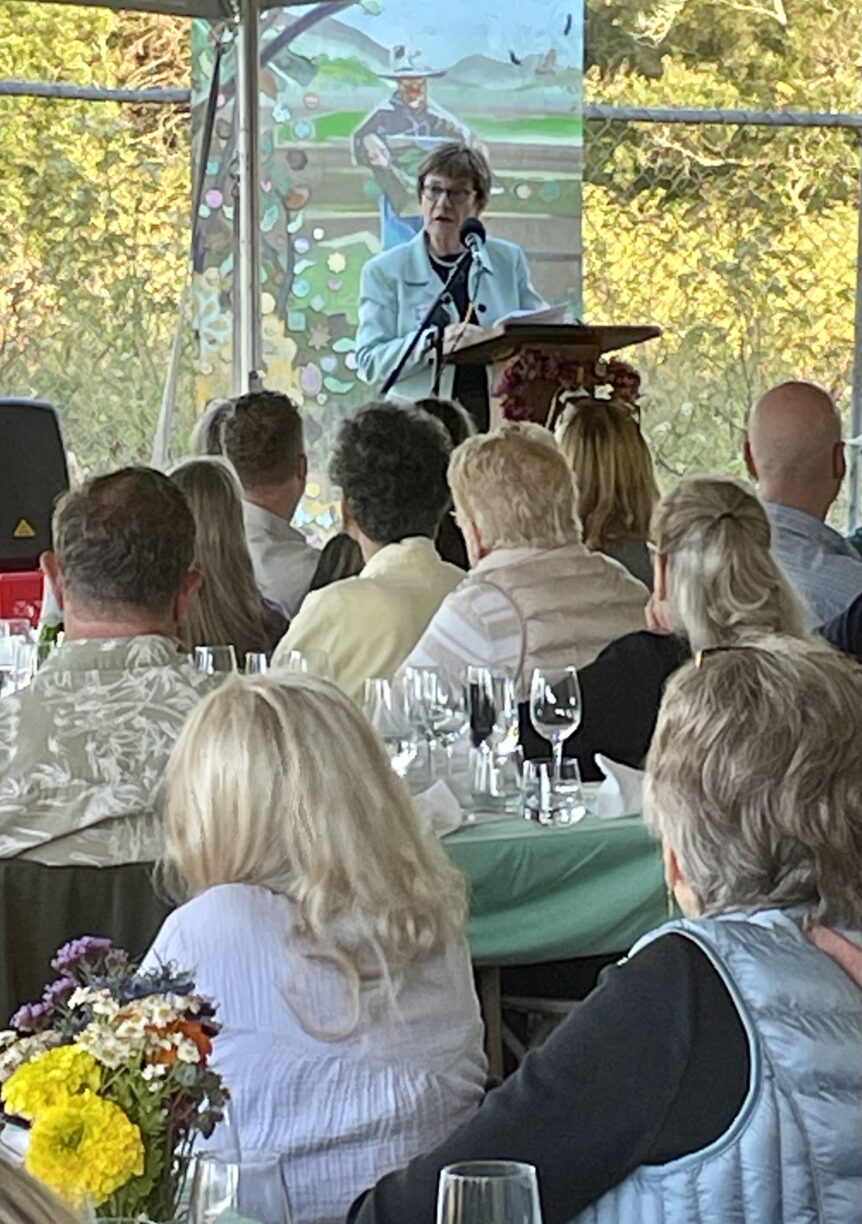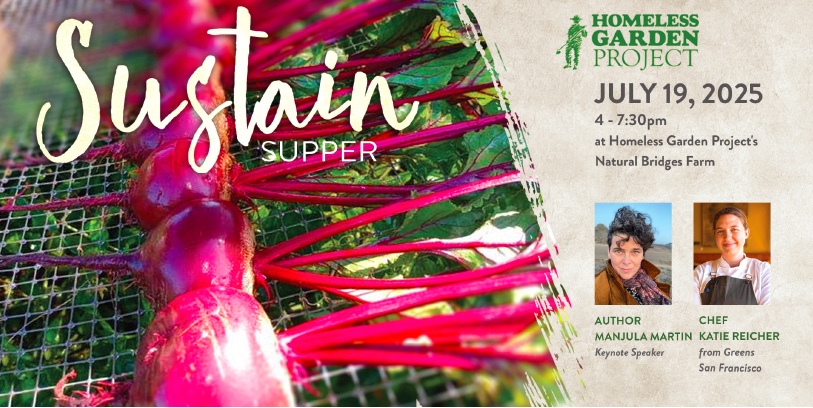We are pleased to share this keynote talk from HGP’s July 20,2024 Sustain Supper by Anne R. Kapuscinski, Director of Coastal Science and Policy program & Professor of Environmental Studies, University of California, Santa Cruz & Chair of Board of Directors, Union of Concerned Scientists. Video of the full presentation is at the bottom of the post with Anne’s talk beginning around 8 minutes and 50 seconds in.
Thank you, Darrie, for your kind introduction. After moving to Santa Cruz in 2018, my
husband, Wayne Barstad and I truly enjoyed attending a Sustain dinner in the summer of
2019- before the pandemic lockdown. So, it’s an honor to speak at this year’s dinner.
I want to talk with you about Active Hope – an approach to taking on big challenges
which I have seen drive the positive outcomes of work by the Union of Concerned
Scientists (now in its 55th year) and by the Coastal Science and Policy program at UC
Santa Cruz (now starting its 7th year). Joanna Macy, renown eco-philosopher and systems
thinker, and Dr. Chris Johnstone, a specialist in the psychology of resilience and positive
change, co-authored the book entitled, Active Hope: How to face the mess we’re in
without going crazy.
Quoting them: “The word hope has two different meanings. The first … involves
hopefulness, where our preferred outcome seems reasonably likely to happen. But if we
require this kind of hope before we commit ourselves to an action, our response gets
blocked in areas where we don’t rate our chances well. The second meaning [of hope] is
about desire… for the kind of world [we] long for…”
“Active Hope is about becoming active participants in bringing about what we hope for.
Like gardening… it is something we do rather than have. It is a process we can apply to
any situation, and involves three key steps. First, we take in a clear view of reality;
second, we identify what we hope for in terms of the direction we’d like things to move in
or the values we’d like to see expressed; and third, we take steps to move ourselves or
our situation in that direction.”
Active Hope at UCS
At the Union of Concerned Scientists, on whose Board I serve as Chair, you may not
think that scientists working on issues such as food and environment or on climate and
energy traffic in hope. After all, our climate scientists have been sounding the alarm
about cutting greenhouse gas emissions for more than 30 years. They know exactly how
many opportunities to slow the pace of climate change have been squandered. They are
observing and experiencing the consequences of climate change they predicted years
ago—and were laughed at for being alarmist. They are clear-eyed about the inevitable
effects of burning fossil fuels.
And yet—the Union of Concerned Scientists models active hope. We know what a
better world could look like. I have witnessed our leadership and staff going through the
steps Joanna Macy lays out in all of their work: realistic assessment, planning to change
what we can in the direction we hope for, and acting on those plans.
And we get results. I think this is in part due to continual practice of active hope: we
apply our energy where we know we can make a difference.
For a team of scientists, that often means weighing in on the science behind proposed
climate policies: in state legislatures, state agencies, or with the governor’s office, with
utilities like PG&E and their regulatory bodies like the California Public Utilities
Commission… and with federal agencies, members of Congress, and the administration.
We make progress wherever we can.
Most recently, that includes a big win on the federal level, as the Environmental
Protection Agency issued four standards limiting pollutants from fossil-fueled power
plants, pollutants such as carbon dioxide emissions and air toxics that are bad for the
climate and for our bodies. The power sector is responsible for about one-third of heat-
trapping emissions—which is why the Union of Concerned Scientists has advocated for
years for strong standards. Dozens of our staff have worked to submit public comments,
drive engagement among our supporters and the general public, build coalitions to
strengthen our position, and engage directly with EPA officials and policymakers.
And for an example of active hope in progress… UCS climate scientists have been
building on many years of work around sea level rise and what’s in store for the
country’s coasts. As you know, sea level rise is slow-moving. It’s also inevitable. Given
piecemeal action so far on protecting communities from destructive flooding and storm
surges that accompany sea level rise… our team is working to better publicize this issue.
And get our policymakers to act before homes, businesses, schools, hospitals, and other
crucial infrastructure become essentially unusable.
Our scientists’ latest analysis in a report entitled, Looming Deadlines for Coastal
Infrastructure, shows that between now and 2050, sea level rise will expose more than
1,600 critical buildings and services to disruptive flooding at least twice per year, along
US coastlines—127 of these structures are in CA. Many of these buildings are public and
affordable housing—a fact that highlights twin crises–a disturbing intersection between
climate change and risk of homelessness. As you know, we already face a housing crisis.
We can’t afford to lose homes in coastal communities where thousands of families live.
This is why the Union of Concerned Scientists is working in partnership with the
National Low Income Housing Coalition, to join our energies around these overlapping
issues, and to demand investments in resilience for all communities at risk.
Progress on these large-scale, national, intersecting issues doesn’t tend to happen fast. As
you know, it’s not always easy or neat to point to the results of our heroic actions. But the
practice of active hope means that the Union of Concerned Scientists keeps at it — putting
rigorous, independent science into action, developing solutions and advocating for a
healthy, safe and just future.
What can you do if you want to help on climate issues?
First of all: Individual action is important. Collective action is important. Structural
change is important.
Locally, you can go to the site https://resilientsantacruzcounty.org/santacruz to join your
neighbors in taking action to cut emissions, to prepare for climate change and create a
healthier, safer future– and find locally relevant resources and links to rebates.
You can also call, email, and meet with your elected officials to demand they support
climate-friendly policies—in general, or on specific issues you care about.
For example, if your passion is local agriculture, you could call on your representatives in
California to pass SB 688. This bill would require the State Energy Resources
Conservation and Development Commission to award grants to research the potential for
siting solar panels on agricultural land, a practice known as agrivoltaics. This integrates
solar panels with habitat restoration, ground water recharge, or cropping and grazing.
You can also go to ucsusa.org to learn more about the issues Union of Concerned
Scientists experts work on, including sustainable agriculture and the role of science in our
democracy. We have several campaigns you can sign on to that will alert your legislators
of your support for climate-friendly policies.
For one example, the “Food” menu tab takes you to a “take action” link where you can
sign on to a call for a federal Farm Bill that ensures climate-smart agricultural policies,
along with nutritional access for vulnerable communities.
And if you want to game-ify your actions, google “Climate Action Button” and hit the
button for more ways to take action.
And don’t underestimate your influence with family and friends and colleagues. You can
be a trusted voice for positive change, and tell others about the actions you’re
taking—and they’ll likely catch on. You have the opportunity to move others to join you
in action.
Active Hope in the Coastal Science and Policy program at UC Santa Cruz
When it comes to the Coastal Science and Policy program at UC Santa Cruz – Active
hope is at the heart of this graduate program. It’s why I fell in love with the
program’s vision and answered the call from UCSC to move here to serve as inaugural
Director. We recruit early career leaders and up their game to design and implement
practical and socially just solutions to climate, biodiversity, and other sustainability challenges in coastal zones around the world. Each entering student has direct experience
with one coastal challenge and often with trying to improve the situation.
A unique feature of our curriculum is: we require each student to work closely with a
partner from the private, non-profit or government sector to co-design a project to help
solve one of the partner’s ‘pain points’ and spend an entire year implementing the project
with their partner.
As you may know, Monterey Bay is a global hotspot of marine biodiversity and known
for coastal solutions piloted by scientists and innovators at UC Santa Cruz and other
organizations in this area. Adding to this international reputation, the Coastal Science and
Policy program—now starting our 7 th year– has proven its ability to recruit and train
highly diverse cohorts of rising leaders, so far from 26 nations—hailing from right here
in Santa Cruz and from nations like Kenya, Mozambique, China, Indonesia, Peru and
Mexico. Our students have partnered with 60+ organizations, such as The Nature
Conservancy, Conservation International, Monterey Bay Aquarium, City of Santa Cruz,
California Legislature, Ocean Science Trust, and Sustainable Ocean Alliance. They win a
continual stream of national and international awards. Just in the last few weeks, 4
students won awards in intense competitions – 2 won national policy fellowships to work
in Washington DC and 2 won international fellowships for STEM students pursuing
social good. Let me tell you about 3 just-graduated students to illustrate active hope.
Alexandra (Ali) Boutros – joined the Coastal Science and Policy program after working
at an emerging startup using microalgae oils to replace petroleum in consumer goods.
She was passionate about how algae could help solve environmental issues including
climate change. Ali focused her graduate degree project on human dimensions of kelp
restoration in California. Kelp forests—the rainforests of our ocean – are deeply
intertwined with communities, livelihoods, and well-being; and the loss of kelp from the
cascading impacts of the recent marine heat wave (2013-2016) had ecological, social and
cultural implications, as well as economic losses. As Ali puts it “Humans are an integral
part of the ecosystem and while we’re responsible for much of its destruction, we also
have a huge part to play in its restoration.”
She partnered with the Nature Conservancy and the California Department of Fish and
Wildlife to systematically compare two experimental, community-led kelp restoration
efforts in California. Ali found that key elements of effective community-led restoration
include: integrating local knowledge, expertise and community into the decision making
process; and having ecological and social metrics of restoration success. And people
impacted by kelp loss wanted to be part of the solution.
Ali’s findings will be incorporated into kelp restoration and management plans being
developed by her partner organizations. She was interviewed by Channel 8 (KSBW) in
late May about this work. She’s now contracted to strengthen a draft “Science Roadmap” for CA Marine Restoration for the Ocean Science Trust. ALSO, she was named an Aspen
Institute Future Climate Fellow, making her part of a growing network of Gen Z leaders.
She came away from the Aspen Institute’s Future Leaders Summit in Washington, DC
energized “[by the] young people who were actively pushing the boundaries of climate
innovation. None of us were jaded (yet); there was enthusiasm and hope.”
Angelo San Pablo started the Coastal Science and Policy program with the goal to
advance sustainable US marine aquaculture— in his words “to improve public awareness
and understanding of aquaculture…[and] …ensure that the industry takes proactive steps
towards equitable, transparent and responsible practices.” Aquaculture now produces
over 50% of global seafood, but must be done sustainably. And the US imports 80% of
our seafood, half of which comes from aquaculture. One way to reduce our seafood
imports is through domestic, sustainable aquaculture for healthy seafood. Angelo saw
that this is possible from previously working at Blue Ocean Mariculture in Hawaii. It’s
the first US offshore fish farm to earn sustainability certification under rigorous standards
of the non-profit, Aquaculture Stewardship Council.
Angelo focused his graduate project on reducing carbon emissions associated with feeds
for farmed fish, partnering with Cargill Aqua Nutrition, one of the world’s largest
aquaculture feed manufacturers. He successfully enhanced their carbon emissions
reporting and expanded it to North America for the very first time, through their
SeaFurther Sustainability program. He improved traceability of ingredients used to make
feeds, identified which ingredients contribute most to carbon emissions and mapped out
alternative ingredients to replace fishmeal and fish oil in aquaculture feeds. Reducing
demand for fishmeal and fish oil– extracted from small ocean fish–will reduce pressures
on ocean food webs especially in the face of climate change impacts.
Angelo also became a national advocate for centering youth voices in aquaculture and
climate policy. He was named one of the first Future Leaders in the Coalition for
Sustainable Aquaculture; and met with members of Congress in DC. And Angelo is one
of our recent winners of a national policy fellowship.
Cindy Matuch entered the Coastal Science and Policy program wanting to link science
with policy to stop ocean plastic pollution. Since the 1950s, plastic production
skyrocketed–increasing 230 fold and is projected to quadruple by 2050. A garbage
truck’s worth of plastic pollution enters the ocean every minute, leading to marine
animals entangled in or eating plastic and degrading into microplastics. Research shows
plastic pollution moves through the food web and into our air, water and bodies, posing
human health risks.
Scientific evidence should guide design of policies that tackle root causes of plastic
pollution and encourage innovation in sustainable alternatives. Cindy began her graduate studies just when the UN started negotiations among 175 nations to create a global plastic
pollution reduction treaty. So, for her year-long project, she partnered with Margaret
Spring, Chief Conservation and Science Officer of the Monterey Bay Aquarium, to push
for a strong, science-based and equitable Global Plastics Treaty. Attending two rounds of
negotiations gave her the rude awakening that science was not central to the negotiations
and wasn’t guiding decisions.
In her own words, here is how Cindy approached this challenge:
“My dream has always been to prevent plastic pollution from harming the ocean and
marine life, which I cherish deeply. I’ve been dedicated to this mission over the past two
years of my graduate studies. Initially, I saw plastic pollution as solely an environmental
issue, but my perspective shifted when I learned the harmful impacts that plastic has on
human health and communities of color.
From participating in the treaty negotiations “.. I realized the importance of a science-
policy interface in the treaty. It connects people and values, making it essential for
effective solutions. During the discussions, I listened to stories from Indigenous people,
communities near petrochemical facilities, NGOs, academics, scientists, health
professionals, and activists. They emphasized the significance of their knowledge in
addressing plastic pollution. I now see the science-policy interface as the power of
listening…. I believe that this collective listening and respect for diverse perspectives is
the embodiment of a science-policy interface.
“I hope to continue connecting science to policy in this field, help inform decisions that
impact everyone, and ultimately aim for a world without plastic pollution.”
Cindy is continuing with the team at the Monterey Bay Aquarium to drive development
of a science-based and equitable global treaty, and also for a U.S. government wide
strategy to tackle plastic pollution (released yesterday by the White House!). AND Cindy
is our 2nd recent winner of a national policy fellowship.Ali, Angelo and Cindy each mobilized active hope. They drew on their deep longing fora better world and tapped into their own experience and the positive energy of others.
Their stories illustrate why I now view our Coastal Science & Policy students and other
emerging young leaders as Earth’s immune response rising up to heal the world. Their
practice of active hope is what keeps me going and being their ally! May it inspire you
too.
Clearly… the mission, approach, and life-affirming outcomes of the Homeless
Garden Project manifest active hope. Especially its transitional employment program for
people experiencing homelessness which has demonstrated incredible positive impact for
its trainees. The project is a model for how each of us in this community can actualize
active hope—through individual and collective acts.
Thank you for listening to me this evening.


